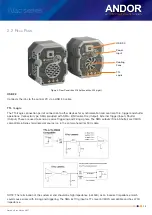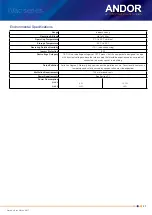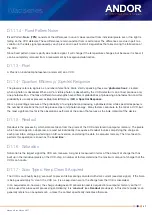
Version 2.0 rev 26 Jan 2017
29
iVac series
APPENDIX C: REFERENCE INFORMATION
U
ltRa
v
ac
tM
t
ecHnology
UltraVac
is Andors proprietary vacuum technology that provides a permanent, hermetically sealed enclosure (without
O-rings) for the sensor. This ensures maximum cooling performance, with a reliability proven through years of use in
Andor cameras such as the iXon EMCCD, iKon and Newton series- the Mean Time Between Failure (MTBF) value is >
100 years.
Outgassing is minimized through assembly in a state of the art facility, with a stringent protocol and use of proprietary
materials (Outgassing is the release of trapped gasses that would otherwise degrade cooling performance and
potentially cause sensor failure). UltraVac also features a single camera window for the best optical performance. For
more information about our UltraVac technology, please visit our website and view the technical article on
.
te c
ooling
The CCD detector is cooled using a thermoelectric (TE) cooler. TE coolers are small, electrically powered devices with no
moving parts, making them reliable and convenient. A TE cooler is actually a heat pump, i.e. it achieves a temperature
difference by transferring heat from its ‘cold side’ (the CCD-chip) to its ‘hot side’ (the built-in heat sink). Therefore the
minimum absolute operating temperature of the CCD depends on the temperature of the heat sink. The maximum
temperature difference that a TE device can attain is dependent on the following factors:
•
Heat load created by the CCD
•
Number of cooling stages of the TE cooler
•
Operating current.
The heat that builds up on the heat sink must be removed and this can be achieved in one of two ways:
1.
Air cooling
: a small built-in fan forces air over the heat sink.
2.
Water cooling
: external water is circulated through the heat sink using the water connectors on the top of the
head.
The iVac supports the
air cooling
option which provides an effective and compact cooling option. Whichever method is
being used, it is not desirable for the operating temperature of the CCD detector simply to be dependent on or vary with
the heat sink temperature. Therefore a temperature sensor on the CCD, combined with a feedback circuit that controls the
operating current of the cooler, allows stabilization of the CCD to any desired temperature within the cooler operating range.
A
ir
C
ooling
Air cooling is the most convenient method of cooling. Even with a fan, a heat sink typically needs to be 10ºC hotter
than the ambient (room) temperature to transfer heat efficiently to the surrounding air. Therefore the minimum CCD
temperature that can be achieved will be dependent on the room temperature.
NOTES:
1. The relationship between the air temperature and the minimum CCD temperature is not 1:1. This is because
TE coolers become less efficient as they get colder
2. Systems are specified in terms of the minimum dark current achievable, rather than absolute temperature.
For dark current specifications, please refer to the specification sheet for your camera
3. Cooling the CCD detector helps you reduce dark signal and its associated Shot Noise












































